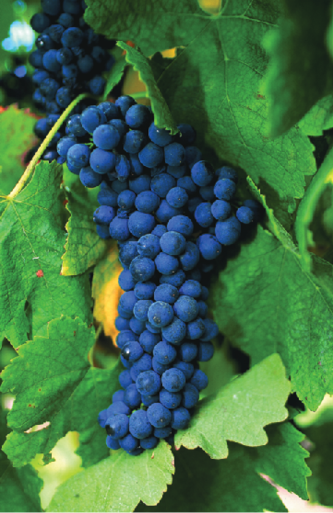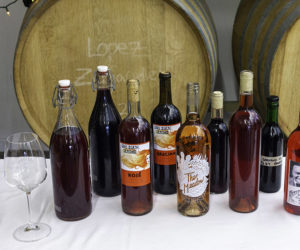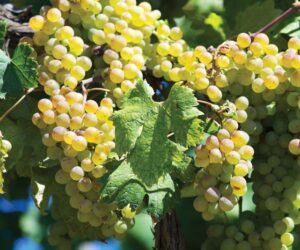
When I was growing up, I watched “The Doris Day Show.” What was so intriguing about the show, and why I remember it today, was the opening song written by Jay Livingston and Ray Evans in the 1950s: “Que Sera Sera (What Ever Will Be).” The song was originally used in the Alfred Hitchcock film, “The Man Who Knew Too Much,” starring Day and Jimmy Stewart, but was popularized by the show, which ran from 1968 to 1973. Circling back around, what the heck does this have to do with this issue’s topic? Well it’s the song, a catchy little tune that comes in to my head every time someone starts talking about Syrah! This tune then proceeds to drive me crazy as I can’t get it out of my head.
Despite the song (which is now stuck in your head, too), the Syrah grape is my favorite. I have a long history of making Syrah in just about every vintage since 2001. As home winemaking goes so often, the vineyards I sourced fruit from changed each year expressing something different and intriguing about the grape itself. Sometimes I had ripe red fruit, and other times it was earthier. Some fruit was higher in acid, though most often it was low and required a tartaric acid supplementation. Another fun aspect of this grape, is that its color expression is generally phenomenal and it is a versatile grape used for blending color into other wines that are color challenged.
Syrah, also known as Shiraz, has a long storied history with writings referencing its use in winemaking going back as far as Pliny the Elder in the year AD 77. While the writings do not specifically mention Syrah, they do refer to a dark skinned grape in the area of France at the time called Vienne, which is now the area known as the Côte-Rôtie in the Northern Rhône Valley. Some have speculated that the grape may have originated near the village of Shiraz, in Iran, hence the name. They then felt it was brought to France via crusaders or general trade routes. However, the likelihood of this having happened is low given that in the late 1990s, researchers at UC-Davis confirmed the parentage of Syrah by DNA fingerprinting.
The confusion here, before the DNA evidence was released, was that there was a dark-skinned grape that produced wine in this area of Iran. Lacking the sophistication of DNA analysis, the researchers had to resort to historical records, which can prove difficult to research. The UC-Davis research showed that the parents of Syrah were determined to be Dureza, a very dark skinned red grape, and as the name implies, a white grape, Mondeuse Blanche. Both of these varieties themselves never amounted to much, and there is no evidence that they were extensively cultivated outside of the Rhône Valley. Therefore it was pretty much confirmed that Syrah is native to the Rhône region valley. The grape Syrah is not to be confused with Petite Sirah, which is a completely different variety.
Collectively in the northern and southern Rhône Valley, Syrah has a long history. It is best known as the predominant grape in northern Rhône blends, specifically in the Hermitage, Cornas and Côte-Rôtie Apellation d’Origine Contrôlée (AOC). Each of the AOC has specific rules on what can and cannot be blended with Syrah. For instance, in Hermitage the blend can have as much as fifteen percent of the white grapes Marsanne and Roussanne. In the Côte-Rôtie the blends can have as much as twenty percent Viognier. And no addition of white grapes is permitted in Cornas. In the southern Rhône, where thirteen types of both red and white grapes are permitted, Syrah is a lesser component in blends where Grenache Noir is the predominant red and other red varieties like Mourvèdre, Cinsault, Cunoise, Muscadin, Terret Noir and Vaccarese are also used.
The current market trend is to blend it with Grenache and/or Mourvèdre. The AOC rules are complex , but it was important that these rules were established throughout France to protect the country’s long-storied wine history from being diluted with less expensive, and lesser quality wines from North Africa in the late 1800s as the French wine industry struggled to recover from the Phylloxera epidemic. Today there are more than six thousand producers in the Rhône Valley, encompassing over 60,000 hectares (~ 150,000 acres).
Australia recognizes Syrah as Shiraz. It is presumed that the name stuck as the cuttings that were brought to the country in the 1830s by James Busby were identified with the names Ciras and Scyras, making it difficult to research the origins of the name, given the Iranian connection mentioned earlier. By the late nineteenth century, Shiraz was one of the most important grape varieties in Australia. It adapted well to the warmer viticulture regions and today encompasses. In the 1970s and 1980s when Australians cut down on their consumption of wine many vineyards were removed. The wine boom of the 1990s saw many of those vineyards replaced, and today there are more than 40,000 hectares (~100,000 acres) of Shiraz planted across the country.
In the United States, where the variety is made into wine under both names, Syrah and Shiraz depending on the market and wine style, most of the plantings are in California, however there are also two notable American Viticultural Areas (AVA) in Washington State — the Naches Heights AVA and the Walla Walla AVA. The increased acreage in California was driven by the increased popularity of the grape created by industry groups such as the Rhone Rangers. However market issues in California since 2009 have resulted in decreased tons crushed dropping from 133,000 tons in 2009 to 109,000 tons in 2011 with almost one-third of that tonnage being produced in the southern San Joaquin Valley. Both the Syrah and Shiraz clones are available in California but they can both equally produce varied styles of wines. The Foundation Plant Services (FPS) department at the UC-Davis lists nine Shiraz clones and eleven Syrah clones available for purchase from their repository.
A versatile variety with many names being produced all over the world likely leads you to assume there are going to be a variety of wine styles associated with it. The descriptors for Syrah can range from earthy (namely mushroom and leather), to fruit characters of blueberry, and blackberry. The tannin structure varies from the types of soils the vines were planted in. Those vines in the Rhône that struggle in rocky soils can produce very tannic wines that need several years to age. Barrel aging is almost a given to aid in softening the tannins regardless of where in the world the fruit was produced.
The Australians in the early 2000s flooded the US market with low tannin fruit bombs that are even slightly sweet, which is something the American palate is finding acceptable in the super premium wine groups so American producers are following suit. The industry affectionately called this style “critter wine” for the namesake animal on the label – for example, Yellow Tail. These wines are produced to sell quickly after the previous vintage and are heavily fined to remove tannin and thus soften the mouthfeel.
My personal experience with Syrah is with grapes that were grown in hotter weather. These conditions produce grape clusters of excellent color and flavors, however the fruit generally comes into the winery at higher pH levels than I would desire. This results in almost an immediate acidification step at the crusher.
Ideally, I would like my finished Syrah red wines to have a final acidity of about 6.5 g/L and a target pH of 3.7. I have made additions as much as 3 g/L of tartaric acid at the crusher and still not made this target. A second addition, based on the acidity measurement performed immediately after completion of the malolactic fermentation determines if additional acid is required. These additions should be made at the first racking after the malolactic conversion and before you put the wine to rest for the winter. In cooler climates an acidity adjustment is likely not necessary. All things considered, it is a relatively easy grape to work with and the toughest aspect of it is the acidity balance.
“Que Sera,” the song, has driven me crazy the last couple of days I have spent writing this manuscript. The tune that has nothing to do with this grape brings me around full circle when I hear the song, I think of the grape, and when I work or talk of the grape, the song pops in my head. I wonder if anything would have been different if the song had been titled, “Que Shiraz?”
Syrah/Shiraz Recipe
(yield: 5 gal/19 L)
Ingredients
• 125 pounds (57 kg) fresh Syrah fruit
• Distilled water
• 10% potassium metabisulfite (KMBS) solution: Weigh 10 grams of KMBS, dissolve into about 50 milliliters (mL) of distilled water. When completely dissolved, make up to 100 mL total with distilled water.
• 5 grams Lallemand “Syrah” yeast
• 5 grams Di-ammonium Phosphate (DAP)
• 5 grams Go-Ferm
• 5 grams Fermaid K (or equivalent yeast nutrient)
• Malolactic fermentation starter culture (CHR Hansen or equivalent)
Other equipment or needs
• 1 15-gallon (57-L) food-grade plastic bucket for fermentation.
• 5-gallon (19-L) carboy, one or two one gallon jugs,
• Racking hoses
• Destemmer/crusher
• Wine press
• Inert Gas – Nitrogen, Argon or Carbon Dioxide
• Ability to maintain a fermentation temperature of 81–86 °F (27–30 °C).
• Thermometer capable of measuring between 40–110 °F (4-43 °C) in one degree increments.
• Pipettes with the ability to add in increments of 1 milliliter
• Ability to measure residual sugar at the completion of fermentation. • Tartaric acid (addition rate is based on acid testing results).
Step by step
1. Clean and sanitize all your winemaking tools, supplies and equipment.
2. Crush and de-stem the grapes. Transfer the must to your fermenter.
3. Add 15 milliliters of 10% KMBS solution (This addition is the equivalent of 50 ppm SO2). Mix well.
4. Take a sample to test for Brix, acidity and pH. Keep the results handy.
5. Layer the headspace with inert gas and keep covered. Keep in a cool place overnight.
6. The next day sprinkle the Fermaid K directly to the must and mix well.
7. Go back to those lab results you took yesterday. Typical brix for this style is 24–25 °B. Typical pre-fermentation acid levels will be 5.0 to 7.0 g/L. Adjust using tartaric acid to pre-fermentation level of 7.5 to 8.0 g/L. Malolactic conversion will drop the acid levels so slightly high acid is OK.
8. Prepare yeast. Heat about 50 mL distilled water to 108 °F (42 °C). Mix the Go-Ferm into the water to make a suspension. Take the temperature. Pitch the yeast when the suspension is 104 °F (40 °C). Sprinkle the yeast on the surface and gently mix so that no clumps exist. Let sit for 15 minutes undisturbed. Measure the temperature of the yeast suspension. Measure the temperature of the must. You do not want to add the yeast to your cool juice if the temperature of the yeast and the must temperature difference exceeds 15 °F (8 °C). To avoid temperature shock, you should acclimate your yeast by taking about 10 mL of the must juice and adding it to the yeast suspension. Wait 15 minutes and measure the temperature again. Do this until you are within the specified temperature range. Do not let the yeast sit in the original water suspension for longer than 20 minutes. When it’s ready, add it to the fermenter and mix.
9. You should see signs of fermentation within about one to two days. This will appear as some foaming on the must surface and it will appear that the berries are rising out of the medium. This is referred to as the “cap rise.”
10. Push the grapes back into the juice to promote color, and tannin extraction. This is called “punching down” and this should be done three times per day. Use a clean utensil.
11. Monitor the Brix and temperature twice daily during peak fermentation (10–21 °Brix). If the temperature shows any indication of exceeding 86 °F (30 °C) cool it down. Do not cool off to less than 81 °F (27 °C).
12. At about 19 °Brix, sprinkle in the DAP and punchdown.
14. When the Brix reaches zero (0 °B) (about 5–7 days), transfer the must to your press, and press the cake dry. Keep the free run wine separate from the press portion and label them.
13. Transfer the wine to your carboys or 1-gallon jugs with airlocks. Make sure you do not have any headspace.
14. Inoculate with your malolactic (ML) bacteria. Check the manufacturer’s instruction on how to prepare and inoculate. Cover the tops with a breather to allow CO2 to escape.
15. Monitor the ML fermentation using a thin layer chromatography assay available from most home winemaking supply stores. Follow the instructions included in the kit.
16. When the ML is complete, measure the residual sugar.
17. Add 2 mL of fresh KMBS (10%) solution per gallon of wine. This is the equivalent to ~40 ppm addition.
18. Measure the pH and titratable acidity. Most importantly you want a finished TA of about 6.5 g/L. The pH is secondary but should be around 3.7. Consider adding acid to adjust the TA prior to settling, but taste the wine first. Do not add acid if the wine is too tart.
19. Place the wine in a cool place to settle.
20. After two weeks, test for SO2 and adjust the SO2 as necessary to attain 0.8 ppm molecular SO2. (There is an SO2 calculator on the Web at www.winemakermag.com/guide/sulfite). Check the SO2 in another two week and adjust. Once the free SO2 is adjusted, maintain at this level. You’ll just need to check every two months or so, and before racking.
21. Rack the wine clean twice over 6–8 months. Consider using some oak chips for 1–2 weeks to add some oak flavors. Fine as needed.
22. Once the wine is cleared (about 8 months), it is almost time to bottle. Make the project fun by having a blending party to integrate the press fraction back into the free run.
23. If all has gone well you can filter and bottle. Maintain sanitary conditions while bottling.







